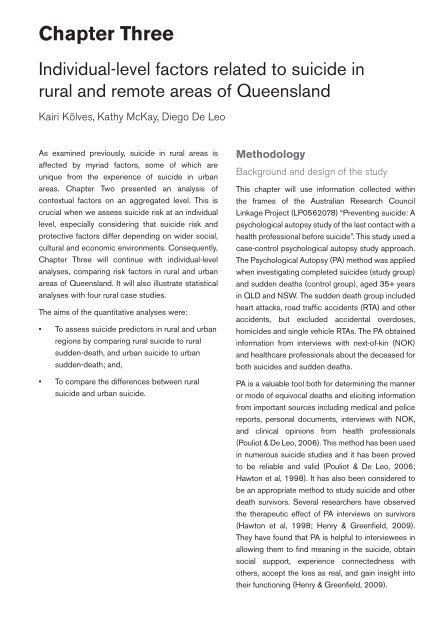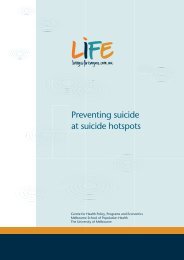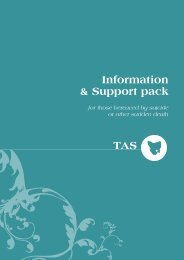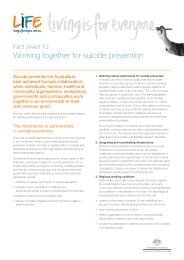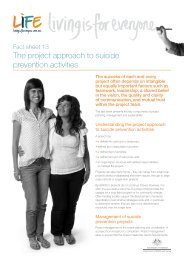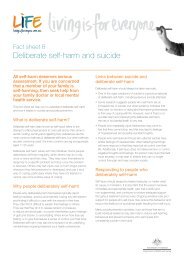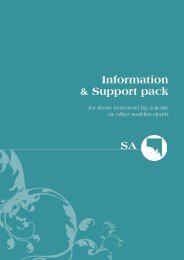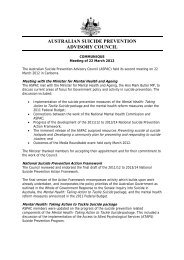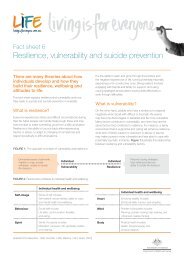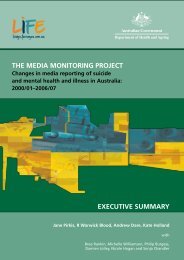SUICIDE in RURAL & REMOTE AREAS of AUSTRALIA - Living is for ...
SUICIDE in RURAL & REMOTE AREAS of AUSTRALIA - Living is for ...
SUICIDE in RURAL & REMOTE AREAS of AUSTRALIA - Living is for ...
You also want an ePaper? Increase the reach of your titles
YUMPU automatically turns print PDFs into web optimized ePapers that Google loves.
Chapter Three<br />
Individual-level factors related to suicide <strong>in</strong><br />
rural and remote areas <strong>of</strong> Queensland<br />
Kairi Kõlves, Kathy McKay, Diego De Leo<br />
As exam<strong>in</strong>ed previously, suicide <strong>in</strong> rural areas <strong>is</strong><br />
affected by myriad factors, some <strong>of</strong> which are<br />
unique from the experience <strong>of</strong> suicide <strong>in</strong> urban<br />
areas. Chapter Two presented an analys<strong>is</strong> <strong>of</strong><br />
contextual factors on an aggregated level. Th<strong>is</strong> <strong>is</strong><br />
crucial when we assess suicide r<strong>is</strong>k at an <strong>in</strong>dividual<br />
level, especially consider<strong>in</strong>g that suicide r<strong>is</strong>k and<br />
protective factors differ depend<strong>in</strong>g on wider social,<br />
cultural and economic environments. Consequently,<br />
Chapter Three will cont<strong>in</strong>ue with <strong>in</strong>dividual-level<br />
analyses, compar<strong>in</strong>g r<strong>is</strong>k factors <strong>in</strong> rural and urban<br />
areas <strong>of</strong> Queensland. It will also illustrate stat<strong>is</strong>tical<br />
analyses with four rural case studies.<br />
The aims <strong>of</strong> the quantitative analyses were:<br />
• To assess suicide predictors <strong>in</strong> rural and urban<br />
regions by compar<strong>in</strong>g rural suicide to rural<br />
sudden-death, and urban suicide to urban<br />
sudden-death; and,<br />
• To compare the differences between rural<br />
suicide and urban suicide.<br />
Methodology<br />
Background and design <strong>of</strong> the study<br />
Th<strong>is</strong> chapter will use <strong>in</strong><strong>for</strong>mation collected with<strong>in</strong><br />
the frames <strong>of</strong> the Australian Research Council<br />
L<strong>in</strong>kage Project (LP0562078) “Prevent<strong>in</strong>g suicide: A<br />
psychological autopsy study <strong>of</strong> the last contact with a<br />
health pr<strong>of</strong>essional be<strong>for</strong>e suicide”. Th<strong>is</strong> study used a<br />
case-control psychological autopsy study approach.<br />
The Psychological Autopsy (PA) method was applied<br />
when <strong>in</strong>vestigat<strong>in</strong>g completed suicides (study group)<br />
and sudden deaths (control group), aged 35+ years<br />
<strong>in</strong> QLD and NSW. The sudden death group <strong>in</strong>cluded<br />
heart attacks, road traffi c accidents (RTA) and other<br />
accidents, but excluded accidental overdoses,<br />
homicides and s<strong>in</strong>gle vehicle RTAs. The PA obta<strong>in</strong>ed<br />
<strong>in</strong><strong>for</strong>mation from <strong>in</strong>terviews with next-<strong>of</strong>-k<strong>in</strong> (NOK)<br />
and healthcare pr<strong>of</strong>essionals about the deceased <strong>for</strong><br />
both suicides and sudden deaths.<br />
PA <strong>is</strong> a valuable tool both <strong>for</strong> determ<strong>in</strong><strong>in</strong>g the manner<br />
or mode <strong>of</strong> equivocal deaths and elicit<strong>in</strong>g <strong>in</strong><strong>for</strong>mation<br />
from important sources <strong>in</strong>clud<strong>in</strong>g medical and police<br />
reports, personal documents, <strong>in</strong>terviews with NOK,<br />
and cl<strong>in</strong>ical op<strong>in</strong>ions from health pr<strong>of</strong>essionals<br />
(Pouliot & De Leo, 2006). Th<strong>is</strong> method has been used<br />
<strong>in</strong> numerous suicide studies and it has been proved<br />
to be reliable and valid (Pouliot & De Leo, 2006;<br />
Hawton et al, 1998). It has also been considered to<br />
be an appropriate method to study suicide and other<br />
death survivors. Several researchers have observed<br />
the therapeutic effect <strong>of</strong> PA <strong>in</strong>terviews on survivors<br />
(Hawton et al, 1998; Henry & Greenfi eld, 2009).<br />
They have found that PA <strong>is</strong> helpful to <strong>in</strong>terviewees <strong>in</strong><br />
allow<strong>in</strong>g them to fi nd mean<strong>in</strong>g <strong>in</strong> the suicide, obta<strong>in</strong><br />
social support, experience connectedness with<br />
others, accept the loss as real, and ga<strong>in</strong> <strong>in</strong>sight <strong>in</strong>to<br />
their function<strong>in</strong>g (Henry & Greenfi eld, 2009).<br />
GriffithBook FINAL 20/09.<strong>in</strong>dd 43<br />
15/11/12 4:28 PM


